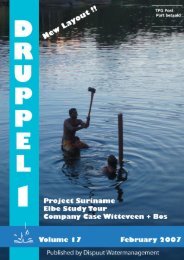Druppel 15-2 - Dispuut Watermanagement
Druppel 15-2 - Dispuut Watermanagement
Druppel 15-2 - Dispuut Watermanagement
Create successful ePaper yourself
Turn your PDF publications into a flip-book with our unique Google optimized e-Paper software.
Hydrology<br />
which simulates the terrestrial water<br />
storage on a monthly basis. Next, these<br />
results have been compared to the estimated<br />
hydrological signal derived from<br />
GRACE measurements.<br />
Despite the large number of processes<br />
influencing the gravity measurements, it<br />
should be possible to filter out the<br />
hydrological (= terrestrial water storage)<br />
signal. To find the relation between the<br />
gravity and the storage, first a hydrological<br />
model was built, which simulates<br />
the terrestrial water storage on a<br />
monthly basis. Next, these results have<br />
been compared to the estimated hydrological<br />
signal derived from GRACE measurements.<br />
Lukulu<br />
Victoria Falls<br />
Figure 2: Zambezi catchment in Southern<br />
Africa.<br />
The Zambezi catchment in Southern<br />
Africa was chosen as study case, mainly<br />
because of its large basin size and the<br />
absence of tidal influences. Because the<br />
quality of the precipitation input data is<br />
very important for the performance of<br />
the hydrological model, different rainfall<br />
algorithms have been investigated in<br />
this research.<br />
The hydrological model consists of two<br />
parts: a GIS based water balance model<br />
and a Muskingum routing model. After<br />
comparing the model results with<br />
observed discharge data it can be concluded<br />
that the model performance is<br />
quite reasonable.<br />
To obtain more knowledge about the<br />
sensitivity of the model to parameter<br />
and data uncertainty, the GLUE-procedure<br />
has been used: firstly to determine<br />
the uncertainty of four main model<br />
parameters, and secondly to determine<br />
the uncertainty in the precipitation and<br />
potential evaporation input data of the<br />
Zambezi model. From the GLUE results<br />
it can be concluded, that no optimal<br />
parameter set exists and that the uncertainty<br />
in the model parameters is less<br />
important then the uncertainty in the<br />
input data.<br />
As a first attempt GRACE data (spherical<br />
harmonic coefficients provided by<br />
GRACE) have been transformed into a<br />
hydrological signal, which is called the<br />
'direct estimation of hydrology from<br />
GRACE data'-method. Comparing the<br />
calculated hydrological signal obtained<br />
from GRACE with the Zambezi-model<br />
results, shows that in qualitative terms a<br />
clear relation exists. Only the amplitude<br />
from the GRACE-data is higher then the<br />
amplitude of the Zambezi-model. This<br />
could be due to various reasons: biomass<br />
accumulation, more variation in<br />
soil-vegetation interaction, and possibly<br />
a model leakage error. By using averaging<br />
kernel functions this latter error may<br />
be reduced.<br />
Miriam Gerrits<br />
14











